LITA Lean IT Foundation
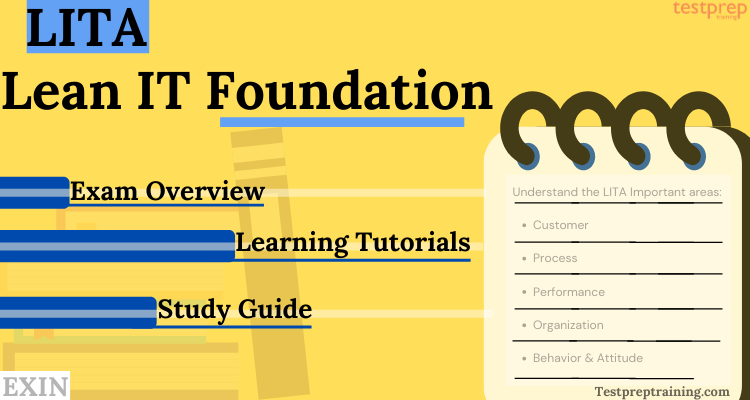
The LITA Lean IT Foundation certification helps candidates in building the fundamental knowledge required for supporting a Lean strategy in IT organizations. In this, candidates will learn and understand the Lean philosophy, how Lean looks at processes to reduce waste, measuring performance and more. However, the Lean IT Foundation also helps IT organizations, ensuring to provide their customers with the best possible services. With understanding customer value, the processes delivering value, managing performance, organizing, and the required attitude and behaviour, IT organizations are helping to develop a continuous improvement mind-set.
Prerequisites for the Exam
Lean IT Foundation exam is designed for managers or IT professionals working in organizations that would benefit from adopting a Lean approach. Moreover, it is recommended that the candidates should have a background of 2 to 3 years’ experience in the field of IT service management.
Learning Objectives: LITA Exam
For the LITA Lean IT Foundation exam learning objectives are provided to understand the concepts for the exam. However, a classification that is widely used when designing assessments for certification and education is Bloom’s Taxonomy of Educational Objectives. This categorizes the learning objectives into six ascending learning levels defining a higher degree of competencies and skills.
Generic Definition from Learning Outcomes
- Knowing about the key facts, terms, and concepts from the manual/ guidance
- Understanding key concepts from the manual/ guidance
- Applying key concepts relating to the syllabus area for a given scenario
- Analyzing and distinguishing between appropriate and inappropriate use of the method/ guidance for a given scenario situation
Qualification Learning Outcomes
- Knowing facts, including terms, concepts, principles, tools and techniques from the Lean IT Foundation curriculum
- Understanding the concepts, principles, and dimensions of Lean IT and can explain how these are applied.
Exam details
For the LITA Lean IT Foundation exam questions, there will be 40 multiple-choice questions that have to be completed in a time duration of one hour. This exam is a foundation level exam in which candidates have to score a minimum of 65% to pass the exam. This exam will provide 2 ECTS credits. However, the exam can be given in English, Japanese, Spanish, Brazilian, Portuguese and Chinese languages. The exam will cost 207$ USD.
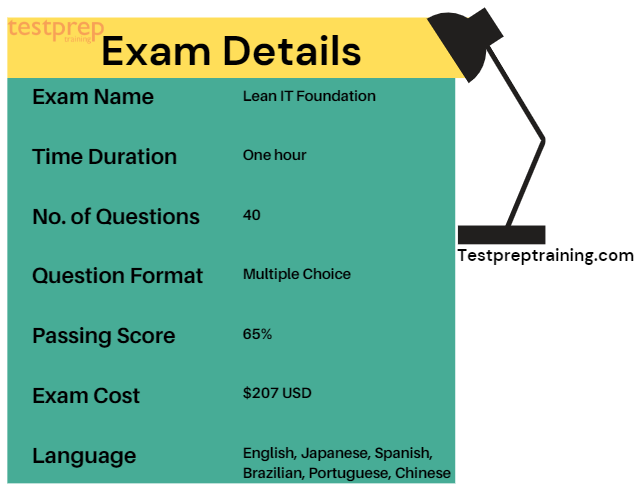
Taking the LITA Exam: EXIN Anywhere
For taking the LITA Lean IT Foundation exam candidates can use EXIN Anywhere. This is an online exam service that lets you save time and effort by not having to travel to an exam center. That is to say, you can sit your exam at home, at the office or any other space where you will not be disturbed.
Course Structure
The LITA Lean IT Foundation certification exam covers the following topics:
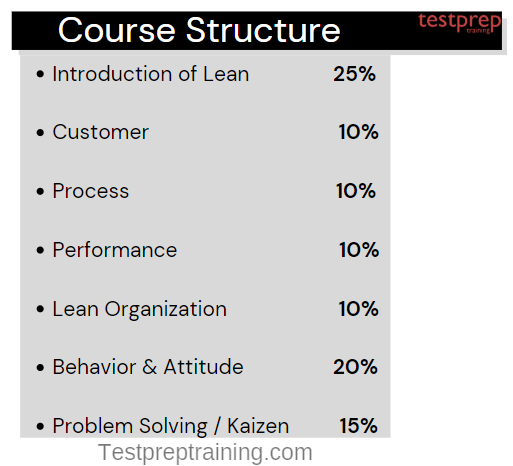
Topic 1: Introduction
1.1 knowing about the historical development of Lean, the key principles underlying Lean and the dimensions for structuring Lean IT.
- development of Lean and the importance of the Toyota Production System.
- key principles underlying Lean like customer value, value stream, flow, pull, perfection
- concepts of waste (muda), variability (mura) and overburden (muri)
- explaining activities like Value-Add, Necessary Non-Value-Add, Non-Value-Add, particularly related to specific IT activities like solving incidents, developing applications, testing
- Planning-Do-Check-Act cycle as the generic method for quality improvement
- Definition of Lean IT
- Dimensions of Lean IT such as Customer, Process, Performance, Organization and Behavior & Attitude
- Key ‘players’ Shingo Prize, Lean IT Association, author community
1.2 Understanding the following aspects dealt with in the Introduction
- Lean principles
- identifying types of waste within an IT organization or process
- Price of poor quality and reasons for using Lean Principles for improving performance
- Types of activities like ability to define what IT activities fall into which category
- ability to explain how the PDCA cycle works on the most basic level
- understanding where Lean IT differs from and complements other methods. The connection of Lean IT with IT service management is specifically investigated.
Topic 2: Customer
2.1 Knowing the key components of the Customer dimension
- Voice of the Customer (VoC) and the types of customers
- Types of customer value
- concept of Critical to Quality (CTQ)
- Ways for analyzing the Voice of the Customer
- Sources of continuous improvement opportunities such as Voice of the Customer, Voice of Business, Voice of the Process, Voice of the Regulator
2.2 Understanding the following aspects related to the Customer
- Types of customer value and the factors that influence customer value
- The link between the Voice of the Customer and Critical to Quality
- constructing a Critical to Quality tree
Topic 3: Process
3.1 Knowing the key aspects of the Process dimension
- Definition of process and the basic processes in an organization
- Key components of a process like goal, result, input, throughput, output, customer,
- concepts of Push and Pull, including justifiable inventory to ensure reduction of variation
- SIPOC model
- The key aspects of a Value Stream Map (VSM), including the identification of waste in the VSM and adding metrics to the VSM
- The most important metrics in a process: Cycle time,Takt time, Lead time, Waiting time, Changeover time, Work in Progress, Parallel Lines, Throughput, Capacity
- Value improvement in processes: possible sources of improvements including specifically heijunka and 5S
- The concepts of value demand and failure demand and the related value and failure streams
3.2 Understanding the following aspects of the Process dimension
- Relationship of process (Value stream) with the other Lean principles
- The difference between Push and Pull systems
- The steps for creating a Value Stream Map, using SIPOC and Value Stream Map
- Waste in a Value Stream Map, ability to identify the symbols for the TIMWOOD waste
- Explain the SIPOC and VSM using IT examples
- The difference between value and failure demand within IT
Topic 4: Performance
4.1 Knowing the key aspects of the Performance dimension
- Definition of performance, as compared to a result
- Definition and requirements for a key performance indicator (KPI)
- The concept of Process Cycle Efficiency (PCE) as a method for understanding time usage.
- understanding the availability of skills and knowledge.
- The combination of Performance indicators, Time and Skills & Knowledge to steer performance
4.2 Understanding the following aspects of the Performance dimension
- Relationship of performance with the PDCA cycle
- The key aspects of a KPI
- Why time is the most important production factor within IT
- The relationship of PCE with VSM
- The role of skills and knowledge in ensuring performance
Topic 5: Organization
5.1 Knowing the key aspects of the Organization dimension
- Organizational requirements for Lean IT structuring for customer orientation, empowerment of frontline to act in delivery of value to customers and speed of communication through the organization
- customer orientation and speed of communication
- Goal of management to empower employees
- Concept and components of the performance dialogue
- Concept and goals of visual management including use of boards\
- Explain the concept of Kanban and its role in visual management
5.2 Understanding the following aspects of the Organization dimension
- Why organizations need to be customer-oriented
- What is the goal of a performance dialogue
- using each of the visual management boards– day board, week board and Kaizen/improvement board
Topic 6: Behavior & Attitude
6.1 Knowing the key aspects of the Behavior & Attitude dimension
- Characteristics of the Lean mindset, Empowerment of the individual to stop the production line (Jidoka/Andon)
- Types of Lean behavior, Quality at the source
- role of managers within a Lean environment
- Lean Leadership
- Valley of despair in relation to people’s expectations over time (Kubler-Ross)
6.2 Understanding the following aspects of the Behavior & Attitude dimension
- The difference between behavior and attitude 10.1
- The difference between traditional management and Lean management
- The behavior and attitude required for successful use of Lean
- Behavior and Attitude in relation to expectations surrounding a change in way of working
Topic 7: Problem Solving / Kaizen
7.1 Knowing the key aspects of Problem Solving / Kaizen
- Definition of Kaizen and Kaikaku as the two forms of improvement within Lean
- Overview of steps in the DMAIC method
- Define phase: Definition of a problem
- Definition of a Pareto chart and its use
- Definition of an Ishikawa (Fishbone) diagram and its use
- Why method for root cause analysis
- Improve phase: inputs for future state: VoC (Voice of the Customer), VoB (Voice of the Business), VoP (Voice of the Process), VoR (Voice of the Regulator)
- explain Poka Yoke as a way to stop mistakes from happening
- A3 method
7.2 Understanding the following aspects of Problem Solving / Kaizen
- Which tools from the other dimensions are used in which phase of the DMAIC cycle
- Prioritization of improvement candidates through feasibility and impact in determining both which problems to solve with a Kaizen and which solutions to implement at the Improve step of the Kaizen
Exam Reference: LITA Lean IT Foundation Study Guide
Exam Policies
EXIN is a driver for professional growth that aspires to continually evolve and develop as an organization. However, being a leading provider of certification programs, it provides exam policies to ensure that potential candidates are able to derive a positive outcome. The vendor makes sure that candidates are familiar with the exam procedures and policies before the actual exam.
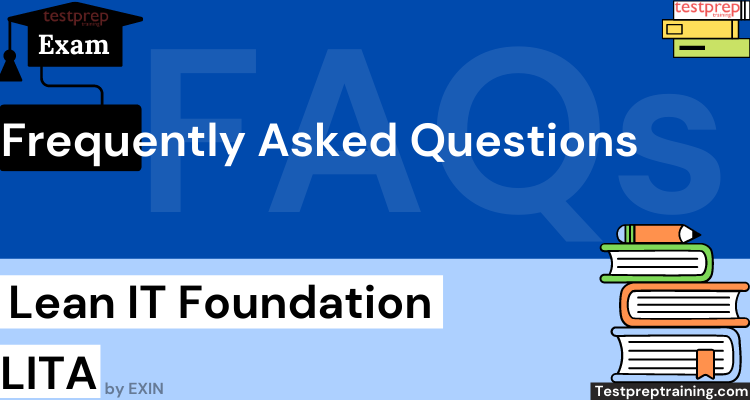
For More Visit: LITA Lean IT Foundation Certification Exam FAQs
Preparation guide for LITA Lean IT Foundation Exam
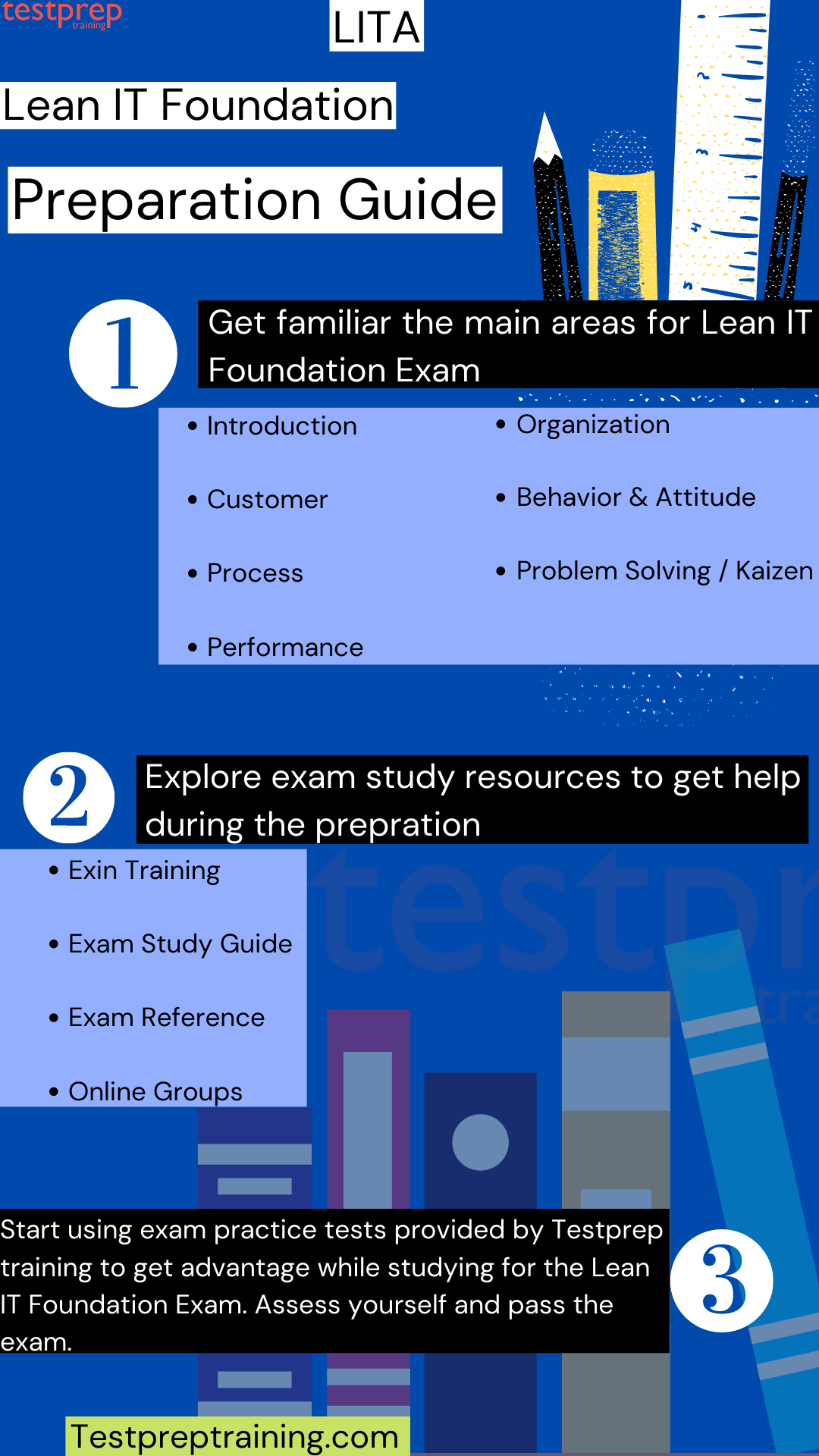
Exam Training
Candidates who want to get certified with EXIN for the Lean IT Foundation exam can choose from several different ways to pass this certification exam. EXIN helps candidates to find the right way to earn the certification by offering various ways that include:
- LITA Lean IT Foundation Training and Exam
- eLearning and Exam
- Virtual Classroom Training and Exam
- Self-study and Online Exam
- Exam Only
Study Guide
There is a study guide provided for the Lean IT Foundation exam to understand the basics concepts and other details involved with the exam. However, the LITA Lean IT Foundation study guide documents the learning outcomes of the Lean IT Foundation and describes the requirements a candidate is expected to meet for demonstrating that these learning outcomes have been achieved. The target audience for this document is:
- Lean IT Association Exam Board
- Accredited Training Organizations
- Persons seeking Lean IT Foundation certification
Exam References
For the Lean IT Foundation exam, various exam references are provided to help candidates during the exam preparation. However, it is recommended that the candidates who study the reference to create a more fundamental and deeper understanding. The references include:
For detailed understanding of Lean Six Sigma tools:
Lean Six Sigma Pocket Toolbook (chapters 1-4, 9) by Michael L. George et al
For understanding how Lean can be applied within the IT environment:
- Lean IT, Enabling and sustaining Your Lean Transformation by Steven C. Bell and Michael A. Orzen
To get deeper understanding of Flow
- This is Lean Authors by Niklas Modig & Pär Åhlström
For background on the origins of Lean
- The Toyota Way by Jeffrey K. Liker
Detail on the behavioral aspects of Lean
- Creating a Lean Culture by David Mann
Online Study Groups
One thing that will be beneficial during the exam preparation time is to join study groups. As these groups will help you to stay connected with the other people who are on the same pathway as yours. Moreover, here you can start any discussion about the issue related to the exam or any query. By doing so, you will get the best possible answer to your query.
Practice Tests
This can be a very essential part that can help you to prepare better for the exam. That is to say, LITA Lean IT Foundation practice exam tests are important as by assessing yourself with these tests you will know about your weak and strong areas. However, by practicing you will be able to improve your answering skills that will result in saving a lot of time. Moreover, the best way to start doing practice tests is after completing one full topic as this will work as a revision part for you. So, make sure to find the best practice sources. Try Free LITA Lean IT Foundation Practice Exam Test Now!

